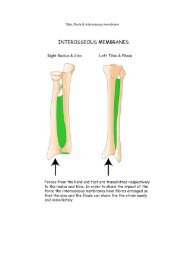GSM 11.11 version 6.2.0 - TTFN Smart card pages
GSM 11.11 version 6.2.0 - TTFN Smart card pages
GSM 11.11 version 6.2.0 - TTFN Smart card pages
- No tags were found...
You also want an ePaper? Increase the reach of your titles
YUMPU automatically turns print PDFs into web optimized ePapers that Google loves.
(<strong>GSM</strong> <strong>11.11</strong> <strong>version</strong> <strong>6.2.0</strong> Release 1997)97TS 100 977 V<strong>6.2.0</strong> (1999-05)number containing the second part of the subaddress data. Both Extension1 record types are set to "calledparty subaddress".Once i), ii), and iii) have been considered the ME performs the updating procedure with EF ADN . If the SIM has noavailable empty space to store the received ADN/SSC, or if the procedure has been aborted, the ME advises the user.NOTE 1: For reasons of memory efficiency the ME is allowed to analyse all Extension1 records to recognize if theadditional or subaddress data to be stored is already existing in EF EXT1 . In this case the ME may use theexisting chain or the last part of the existing chain from more than one ADN (LND, MSISDN). The ME isonly allowed to store extension data in unused records. If existing records are used for multiple access, theME shall not change any data in those records to prevent corruption of existing chains.Erasure:Request:Purge:The ME sends the identification of the information to be erased. The content of the identifiedrecord in EF ADN is marked as "free".The ME sends the identification of the information to be read. The ME shall analyse the data ofEF ADN (subclause 10.4.1) to ascertain, whether additional data is associated in EF EXT1 or EF CCP .If necessary, then the ME performs the reading procedure on these EFs to assemble the completeADN/SSC.The ME shall access each EF which references EF EXT1 (EF EXT2 ) for storage and shall identifyrecords in these files using extension data (additional data or called party subaddress). Note thatexisting chains have to be followed to the end. All referred Extension1 (Extension2) records arenoted by the ME. All Extension1 (Extension2) records not noted are then marked by the ME as"free" by setting the whole record to 'FF'.NOTE 2: Dependent upon the implementation of the ME, and in particular the possibility of erasure of ADN/SSCrecords by Phase 1 MEs, which have no knowledge of the EF EXT1 , it is possible for Extension1 records tobe marked as "used space" (not equal to 'FF'), although in fact they are no longer associated with anADN/SSC record.The following three procedures are only applicable to service n°3 (FDN).FDN capability request. The ME has to check the state of service n°3, i.e. if FDN is "enabled" or "disabled". In case ofenabled FDN, the ME has to switch to a restrictive terminal mode (see <strong>GSM</strong> 02.07). To ascertain the state of FDN, theME checks in EF SST whether or not ADN is activated. If ADN is not activated, service n°3 is enabled. If ADN isactivated, the ME checks the response data of EF ADN . If EF ADN is invalidated, service n°3 is enabled. In all other casesservice n°3 is disabled.FDN disabling. The FDN disabling procedure requires that CHV2 verification procedure has been performedsuccessfully and that ADN is activated. If not, FDN disabling procedure will not be executed successfully. To disableFDN capability, the ME rehabilitates EF ADN . The invalidate/rehabilitate flag of EF ADN , which is implicitly set by theREHABILITATE command, is at the same time the indicator for the state of the service n°3. If ADN is not activated,disabling of FDN is not possible and thus service n°3 is always enabled (see FDN capability request).NOTE 3: If FDN is disabled (by rehabilitating EF ADN ) using an administrative terminal then the FDN disablingprocedure of this administrative terminal need also to rehabilitate EF IMSI and EF LOCI to ensure normaloperation of the SIM in a phase 1 ME or a phase 2 ME which does not support FDN.FDN enabling. The FDN enabling procedure requires that CHV2 verification procedure has been performedsuccessfully. If not, FDN enabling procedure will not be executed successfully. To enable FDN capability, the MEinvalidates EF ADN . The invalidate/rehabilitate flag of EF ADN , which is implicitly cleared by the INVALIDATEcommand, is at the same time the indicator for the state of the service n°3 (see FDN capability request). If ADN is notactivated, service n°3 is always enabled.Invalidated ADNs may optionally still be readable and updatable depending on the file status (see clause 9.3)The following three procedures are only applicable to service n°31 (BDN).BDN capability request. The ME has to check the state of service n°31, i.e. if BDN is "enabled" or "disabled". BDNservice is "enabled" only if service n°31 is allocated and activated, and EF BDN is not invalidated. In all other cases, theBDN service is "disabled".ETSI








